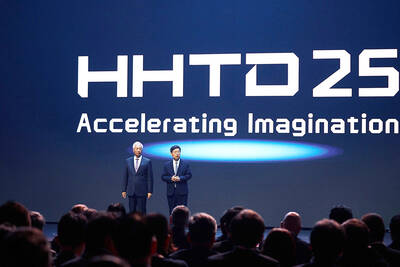Offshore wind power developers yesterday railed against the government’s plans to cut the preliminary feed-in tariff (FIT) by 12.7 percent over the next two decades.
The Ministry of Economic Affairs (MOEA) on Thursday proposed to cap the FIT at NT$5.106 per unit for the next 20 years, drawing the ire of all five developers that are overseeing offshore wind projects in Taiwan.
The change is unacceptable and a significant blow to the viability of ongoing projects and Taiwan’s progress toward renewable energy development, Copenhagen Infrastructure Partners (CIP), Northland Power Inc, Orsted A/S, Wpd Group and Yushan Energy Co (玉山能源) said in a joint statement.
The government’s U-turn has damaged Taiwan’s reputation in the global market and rocked investors’ confidence, as they were duped by the ministry, which originally promised an FIT of NT$6 per unit, the developers said, adding that many are reassessing their investment thesis.
Any effects on Taiwan’s first batch of offshore wind projects — with capacity totaling 3.5 gigawatts — would compromise the nation’s ambition to tap into clean energy and become a leading regional supplier in the industry, they said.
Aside from the FIT cut, the developers said that they were also concerned about the ministry’s plans to cap the government’s purchase of offshore wind-generated energy to 3,600 operating hours per year and the cancelation of a tiered FIT scheme.
Under a tiered FIT scheme, offshore wind farm operators would be paid at a higher rate when a facility goes online, with the rate tapering off later.
“The loss of a tiered FIT scheme would deal a significant blow to financing efforts, as that arrangement was pivotal in winning over lenders,” CI Wind Power Development Taiwan Co Ltd director Marina Hsu (許乃文) told the Taipei Times.
“While we were able to convince lenders to commit to loans of between eight and 10 years, the lack of a tiered FIT scheme could lengthen the time frame as much as twofold,” Hsu said.
“Lenders are not likely to take on additional exposure if loan repayment periods are lengthened any further,” she said, adding that Taiwan’s green financing landscape is not as mature as the ministry claims.
Among other global offshore wind developers, CIP has committed to NT$20 billion (US$648.3 million) in contracts with Taiwanese suppliers to meet the government’s requirements, she added.
In light of CIP’s commitments, it is not fair to subject the company to an across-the-board FIT cut, she said, adding that commitments by some of its peers have not progressed beyond the signing of memorandums of understanding.
While some of the company’s peers have begun a race to sign power purchase agreements at the current FIT rate to lock in returns, CIP would carry out the commitments it has made, she said.
However, the company is no longer sure about future endeavors, she added.
CIP is conducting a thorough re-evaluation of its projects in Taiwan and hopes to continue negotiations with the government, Hsu said.
“The MOEA’s proposed changes stray from prevailing development trends across the globe and have exceeded our worst expectations,” she said.

Shiina Ito has had fewer Chinese customers at her Tokyo jewelry shop since Beijing issued a travel warning in the wake of a diplomatic spat, but she said she was not concerned. A souring of Tokyo-Beijing relations this month, following remarks by Japanese Prime Minister Sanae Takaichi about Taiwan, has fueled concerns about the impact on the ritzy boutiques, noodle joints and hotels where holidaymakers spend their cash. However, businesses in Tokyo largely shrugged off any anxiety. “Since there are fewer Chinese customers, it’s become a bit easier for Japanese shoppers to visit, so our sales haven’t really dropped,” Ito

The number of Taiwanese working in the US rose to a record high of 137,000 last year, driven largely by Taiwan Semiconductor Manufacturing Co’s (TSMC, 台積電) rapid overseas expansion, according to government data released yesterday. A total of 666,000 Taiwanese nationals were employed abroad last year, an increase of 45,000 from 2023 and the highest level since the COVID-19 pandemic, data from the Directorate-General of Budget, Accounting and Statistics (DGBAS) showed. Overseas employment had steadily increased between 2009 and 2019, peaking at 739,000, before plunging to 319,000 in 2021 amid US-China trade tensions, global supply chain shifts, reshoring by Taiwanese companies and

Taiwan Semiconductor Manufacturing Co (TSMC) Chairman C.C. Wei (魏哲家) and the company’s former chairman, Mark Liu (劉德音), both received the Robert N. Noyce Award -- the semiconductor industry’s highest honor -- in San Jose, California, on Thursday (local time). Speaking at the award event, Liu, who retired last year, expressed gratitude to his wife, his dissertation advisor at the University of California, Berkeley, his supervisors at AT&T Bell Laboratories -- where he worked on optical fiber communication systems before joining TSMC, TSMC partners, and industry colleagues. Liu said that working alongside TSMC

TECHNOLOGY DAY: The Taiwanese firm is also setting up a joint venture with Alphabet Inc on robots and plans to establish a firm in Japan to produce Model A EVs Manufacturing giant Hon Hai Precision Industry Co (鴻海精密) yesterday announced a collaboration with ChatGPT developer OpenAI to build next-generation artificial intelligence (AI) infrastructure and strengthen its local supply chain in the US to accelerate the deployment of advanced AI systems. Building such an infrastructure in the US is crucial for strengthening local supply chains and supporting the US in maintaining its leading position in the AI domain, Hon Hai said in a statement. Through the collaboration, OpenAI would share its insights into emerging hardware needs in the AI industry with Hon Hai to support the company’s design and development work, as well